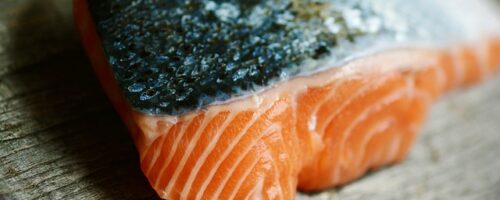
Vancouver, BC
How is it produced?
- Salmon are known to be anadromous – living in both fresh and saltwater. Naturally their life begins in fresh water then they feed, grow, and mature in saltwater only to return to freshwater to spawn to continue the cycle (Fisheries, NOAA, 2023). Salmon is highly valued by many Canadians not only for its taste but also for the diverse range of essential nutrients it provides. Salmon is renowned for its abundance of omeg-3 and omega-6 fatty acids, which play a vital role in promoting human brain growth (Gibbons, 2010). Salmon is produced either by being caught in the wild by fisheries, or by fish-farming.
Describe the supply chain to the store shelf in Canada:
- According to Government of Canada (2021), the top 2 suppliers of fish and seafood are imported from the United States (1.67B) and China (520M). Of this import, Salmon was the top species to be imported. Salmon is sourced either by fisheries within Canada or imported from other countries. The fish are processed and packaged. Then the salmon is distributed to grocery stores across Canada. The consumer is then able to buy the fish directly from the supermarket.
What is the power balance between the producer and seller?
- the producer of Salmon has control over the salmon supply because they go out and catch or farm the fish. They can influence factors like pricing, quality and availability
- The seller power determines on how strong the market for salmon is. They also make the distribution connections to sell the salmon.
Can you recommend changes to the system to improve the balance?
- Although imposing fines can prompt companies to reconsider their fishing methods, additional measures must be taken to address the issue effectively.
- Governing parties should set up a “total allowable catch, (TACs) for all stocks and then allocate quotas to individual States” (Caddell & Molenaar, 2019). This would reduce the temptation to overfish.
- Another suggestion is the monies allocated for subsidies to fisheries can be cut back and a portion used to improve compliance by “using more market-based measures and improved monitoring technology” (Page 289)
References/Resources:
Caddell. R, & Erik J Molenaar. (2019). Strengthening International Fisheries
Law in an Era of Changing Oceans. Hart Publishing.
Fisheries, N. (2023, May 31). Atlantic salmon (protected). NOAA. https://www.fisheries.noaa.gov/species/atlantic-salmon-protected#:~:text=Where%20They%20Live,%2C%20Europe%2C%20and%20northwestern%20Russia
Government of Canada, F. and O. C. (2022, October 31). Government of Canada. Government of Canada, Fisheries and Oceans Canada, Economics, Statistics, and Data Governanceh. https://www.dfo-mpo.gc.ca/ea-ae/economic-analysis/Canada-Fish-Seafood-trade-commerce-poisson-fruits-de-mer-eng.html
Gibbons, A. (n.d.). The world’s first fish supper | science | AAAS. https://www.science.org/content/article/worlds-first-fish-supper

